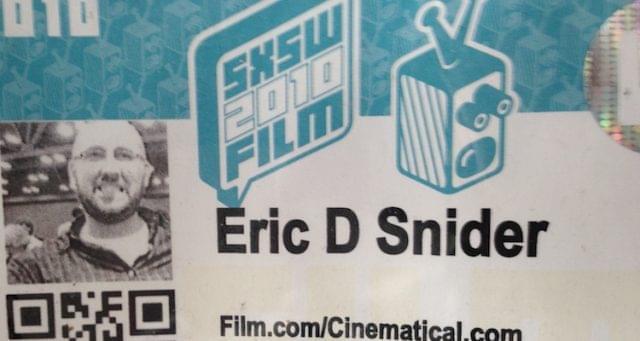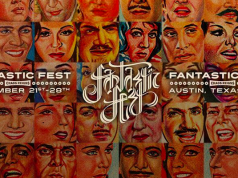
[#1] They like to kick off the South by Southwest Film Festival with a kick-ass movie, so it’s fortunate that this year, someone actually made a movie called “Kick-Ass.” If ever a movie was designed for the SXSW crowd — mostly young, male, and slightly geeky — it was this, an action comedy based on a graphic novel, featuring superheroes, buckets of blood, and outrageously vulgar jokes. Imagine if Judd Apatow and Robert Rodriguez teamed up to make a Spider-Man movie.
“Kick-Ass” is about an ordinary teen named Dave (Aaron Johnson) who wonders why no one has ever tried to re-create themselves as a superhero. Bruce Wayne proved you don’t need supernatural powers, only ingenuity (and possibly a lot of money). Dave becomes the titular hero and soon encounters people who are taking the whole thing a lot more seriously than he is, including a father and daughter played by Nicolas Cage and the soon-to-be-infamous Chloe Moretz. (She played Joseph Gordon-Levitt’s little sister in “500 Days of Summer.”) Christopher Mintz-Plasse — aka McLovin — is on hand, too.
The film, scheduled for wide release on April 16, was crowned the Next Big Thing in December, when it played at Harry Knowles’ Butt-Numb-A-Thon and beat everything — including the sneak preview of “Avatar” — in terms of audience reaction. Directed by Matthew Vaughn (“Stardust,” “Layer Cake”), “Kick-Ass” certainly does not lack for big laughs and enjoyable action, though its mixture of comic book homage and comic book parody doesn’t always work. Is it the future of comic book movies? I don’t know about that, but it will probably be a big hit, and it deserves to be.
I hope a similar fate is in store for “Micmacs,” the latest whimsical delight from “Amelie” director Jean-Pierre Jeunet, which is also a repeat from Butt-Numb-A-Thon. (On the one hand, only a couple hundred people are able to attend BNAT. On the other hand, most of them live in Austin, so it’s kind of redundant when SXSW shows the same movies three months later.) At Saturday night’s screening, a very animated Jeunet said “micmacs” is a slang term for “shenanigans,” and added that he finds the word “shenanigans” hilarious, which I can definitely get onboard with.
“Micmacs” concerns a gentle movie buff named Bazil who sets out to get revenge on the weapons manufacturers whose products led to his father’s death and his own unrelated injury from a stray bullet. Revenge films tend to be nasty, but this one is exceedingly pleasant and merry, owing to Bazil’s good nature and the team of misfits who assist him, including a contortionist, a human cannonball, and other odd ducks. Jeunet demonstrates as much wit and energy as he did in the beloved “Amelie,” so here’s hoping “Micmacs” gets that kind of attention.
It’s not just the old pros delivering popular entertainment at SXSW. Will Canon, who has made four shorts since 2001, has expanded one of them into his first feature, “Brotherhood,” which is playing in competition here and winning over crowds with its fast-paced and energetically stupid story. It deals with a fraternity initiation prank that goes awry, and instead of all the pledges learning about the purpose of fraternities by enjoying some intense but socially acceptable homoeroticism, one of them gets shot. Whoops! Things get really dumb from there, mostly because the characters themselves are really dumb. But there’s no denying the 81-minute lark (which stars Jon Foster, Trevor Morgan, and Lou Taylor Pucci) is lively, never boring, a good example of what breezy direction and tight editing can do for a ludicrous screenplay.
[#2] The programmers at South by Southwest know that Austin audiences are in the mood for fun, so they tend to schedule a lot of comedies. But they take it a step further: They also schedule a lot of movies about comedy. Past fests have included a road-trip documentary with Ray Romano, an account of Jeffrey Ross entertaining the troops in the Middle East, and comedian Doug Benson experimenting with a month of marijuana withdrawal.
This year, the inner workings of comedy are explored in two films, “American: The Bill Hicks Story,” a biopic of the late comedian, and “Saturday Night,” a behind-the-scenes documentary about “Saturday Night Live.” Both movies, predictably, are funny, but they’re also insightful with regard to how humor is created and why it’s effective.
Bill Hicks struggled with drugs and alcohol before finally getting clean and starting to enjoy life — and that’s when he got cancer and died, in 1994, at the age of 32. It’s the kind of cruel irony the comedian would have appreciated. “American” uses interviews with friends and family, plus an abundance of home videos and still photos, to tell Hicks’ life story from beginning to end.
He started doing stand-up as a teenager in Houston, known for his perceptive character-driven routines and his PG-rated material. Later, he started to dabble in booze and drugs, and his stand-up act changed accordingly. He became vulgar. His routine got angrier — and, in the audience’s view, a lot funnier. He was less restrained, more outrageous, more of a spectacle. Then, of course, he started to drink TOO much, and he went from “outrageous” to “unreliable.”
If the clips in the film are any indication, Hicks became more strident and passionate after he sobered up, and less funny. Most of his post-teenage career was marked by a willingness to address serious subjects that most comedians skip. When he was on his game, he did a terrific job breaking things down to their basic, absurd elements. He could get laughs — not just shock laughs, but legitimate laughs — even when talking about things like social injustice and consumerism. But the later performances are short on laughs, long on haranguing: He seems to have become a “message” comedian. Or, at any rate, that’s the impression we get from the snippets included in the movie. It’s still a fascinating doc, though, well put together and continuously entertaining.
The current cast of “SNL” apparently is not quite as tormented as Hicks was (or as past “SNL” casts were), but that doesn’t change the fact that comedy ain’t easy. “Saturday Night,” directed by James Franco, has cameras documenting nearly every aspect of a typical show week, in this case the week of Dec. 6, 2008, when John Malkovich was the host. (Franco himself had hosted once and has since hosted again.) And if it sounds exhausting just to put on a live 90-minute show late on a Saturday night, wait till you see what the writing process looks like.
The comedy sausage factory is fascinating to watch. Given almost unlimited access, Franco takes us into the offices where the writers and cast members work on their material. With a premise established, they’ll shoot possible jokes back and forth, trying to find the one that will be funniest not just now, in the moment, but later, when it’s written down and rehearsed and televised. We see sketches practiced and then abandoned. We see a complete failure at the table read, a sketch that goes up in flames and is never heard from again.
As a big fan of “SNL” and TV production in general, I don’t know if there’s anything in Saturday Night that I hadn’t already learned from the various books that people have written on the subject. But it’s very cool to see a typical show from the pitch meeting to the live performance, if only to stand in awe at the sheer volume of physical and mental energy that goes into it.
Speaking of “SNL,” cast members Will Forte, Kristen Wiig, and Seth Meyers were in Austin for the premiere screening of “MacGruber,” based on Forte’s “MacGyver” parody from the show. (Forte and Wiig star in the film; Meyers was there for moral support.) You hear they’ve made another movie based on an “SNL” sketch and you think, “Good heavens, what have we done to deserve this?” For many of us, the memory of “Blues Brothers” and “Wayne’s World” has faded, while the scars of “A Night at the Roxbury” and “The Ladies Man” linger. But “MacGruber” is actually a really funny spoof of 1980s action comedies, expanding the SNL character enough to sustain a feature film — it’s not just 90 minutes of MacGruber blowing things up — without completely abandoning his roots.
Forte has always struck me as a fearless comedian, willing to go to any length necessary to get the laugh. I’ve often admired his “SNL” sketches, as well as his movie, “The Brothers Solomon,” for having the guts to keep doing a joke, over and over again, past the point where it’s funny, to the point where it becomes annoying, to the point where it becomes hilarious again. A lot of comics lose their nerve halfway through, but not Forte. “MacGruber” is based on the premise that the character himself is incompetent, craven, imbecilic, petty, and belligerent … and yet someone has made a movie about him anyway. The very idea goes against the basic rules of comedy — the main character usually needs to have some redeeming qualities — but “MacGruber,” while not brilliant by any means, succeeds anyway.
[#3] Austin’s Alamo Drafthouse, a paradise for local moviegoers and a South by Southwest screening venue, is owned by Tim League, who’s also one of the founders of the genre-centric Fantastic Fest. Since there’s plenty of natural overlap between the two fests’ sensibilities, last year SXSW introduced SX Fantastic, a section of midnight films programmed by League. You got your Fantastic Fest in my SXSW! No, you got your SXSW in my Fantastic Fest! Et cetera!
These films tend to be full of horror and shocks, often the weirdest of the weird, the most fantastic of the fantastic. So when word got out early in the week that one of the SX Fantastic titles, “A Serbian Film” (that’s actually the name), was among the most disturbing things League had ever seen, people were interested. Tim League has seen some crazy stuff. If there are things in “A Serbian Film” that bothered him, well….
League reiterated those sentiments in his introduction to “A Serbian Film” at its world premiere screening Sunday night. The audience was eager to endure whatever it was that had given him pause, if only so they could say they’d done it. And let me tell you, League didn’t oversell it. I can say without hesitation that some of the events depicted in “A Serbian Film” are the most disturbing things I’ve ever seen in a movie.
The film is about a retired male porn actor, now married with a young son, who is persuaded to make one more film that will pay so much he’ll be set for life. With his wife’s consent, he signs on, even though the producer won’t tell him what the film is about, or who his co-stars are, or what he’ll have to do. (Note: Do not agree to appear in porn films if they won’t tell you in advance whom you’ll be having sex with. That’s a red flag.) Needless to say, horrible, horrible things happen.
It’s not that the material in “A Serbian Film” is particularly graphic or realistic. In fact, the most infamous scene has one major component that looks pretty fake. But it doesn’t matter: It’s the idea of what’s happening that’s so unsettling. We’re talking about physical and sexual violence, perverse and twisted things being done to the wrong people, by people who should not be doing them. Think of your major taboos. They’re nearly all covered, plus some you probably couldn’t have thought of.
On the surface, “A Serbian Film” is about the psychological damage that can be caused by graphic images — which is a little disingenuous, since the movie is full of them. But the filmmakers say the title isn’t random: The film is a metaphor for what they, as Serbs, have experienced at the hands of their government. I freely admit that I don’t know enough about Serbian politics to say whether the analogy is valid. The only difference it would make is that it would help the viewer determine whether “A Serbian Film‘s” content is justified by the point it’s making. But it’s not like the images become less disturbing because you think, “Ah, yes, this brutal rape scene is making some insightful socio-political commentary.” It’s still a brutal rape scene.
Another SX Fantastic film, “Monsters,” was quite a bit less traumatic, as you’ll find out when Magnet Releasing distributes it theatrically. (Don’t hold your breath for “A Serbian Film.”) It has a terrific premise. Six years ago, a space probe crashed in Central America, releasing alien life forms into the jungle — life forms that the Earthlings haven’t been able to control or destroy. So basically, every now and then one of these alien things tromps into a coastal city and destroys stuff. In the midst of one of these attacks, a news photographer is hired by his boss to find the boss’ daughter and return her safely to the United States. Think “It Happened One Night,” only dramatic rather than comic, set against a backdrop of “Cloverfield.”
The film’s flaw, alas, is that the romantic drama is predictable and the characters aren’t all that interesting. It’s the monster stuff that’s fun, and while there’s plenty of it — well made, too, very suspenseful and convincing — it’s overshadowed by the lackluster non-monster stuff. I still think the movie’s worth watching, though, and I’m eager to see what writer-director Gareth Edwards does next.
Porn stars, monsters, and graphic violence come up a lot in “American Grindhouse,” a documentary about the history of exploitation films. (OK, “grindhouse” and “exploitation” are not always synonymous. In fact, the movie addresses that.) Written and directed by Elijah Drenner, the flick has interviews with a ton of relevant filmmakers, along with clips going back a hundred years. As you might have suspected, it was only a few minutes after the movie camera was invented that someone thought, “Hey, let’s have people get naked in front of this!”
Grindhouse isn’t exactly my forte, but I found the doc absolutely fascinating from a historical perspective. It puts the stages of film evolution in context, showing how they were influenced by each other and by external social and political factors. I’m a sucker for that kind of thing. Truth be told, I’d rather learn about grindhouse cinema than actually watch most of it. The same may be said of Serbian cinema as well.
[#4] One of the more unusual surprises at South by Southwest this year was “Barry Munday,” a comedy about a man who loses his testicles and then learns that a one-night stand he had before the incident has resulted in pregnancy. The fact that he was too drunk to remember the tryst is irrelevant, as is the fact that the woman hates him. What matters is that this is the only chance he’ll ever have to be a father.
What’s surprising about the film is that its loose, goofy central performance is by Patrick Wilson, who has nearly always come across in movies as stiff and flat. (The major exception was “Hard Candy,” in which he was threatened with castration. Apparently what you have to do to get a great performance out of Patrick Wilson is talk about cutting his junk off.) “Barry Munday” has some odd plot holes, but they are more than outweighed by Wilson’s character — a kind of horndog Michael Scott — and by Judy Greer‘s adorably snarky turn as the dowdy woman he knocks up.
Speaking of frustrated, emasculated men, “Cold Weather” is about a directionless young fellow named Doug (Cris Lankenau) who dropped out of college before finishing his criminal justice degree and now lives with his sister and works in an ice factory. What starts out looking like another one of those boring movies about a bored guy takes a turn for the delightful when Doug tries to solve a mystery surrounding his ex-girlfriend’s sudden reappearance in town. It’s a real mystery, too, with clues and stakeouts and surveillance and everything. Since Doug’s a hipster slacker (the film is set in Portland), his first step is to buy a Sherlock Holmes-style pipe. Oh, and he’ll need a ride to the pipe store, too, because he doesn’t have a car.
Directed by Aaron Katz (who made the mumblecore-ish “Quiet City” and “Dance Party, USA”), “Cold Weather” is ultimately about Doug reconnecting with his sister (played by Trieste Kelly Dunn). It uses the mystery and its accompanying film noir elements as a playful way of addressing the sibling relationship, infusing what could have been just another mopey indie drama with some real zest.
Speaking of solving mysteries and taking the law into your own hands, that’s what Michael Caine does in “Harry Brown,” a grim, unintentionally silly drama from England. Caine plays the title character, an old widower whose friend is killed by street punks in his crime-ridden neighborhood, leading him to seek justice on his own. If it sounds a lot like “Death Wish,” that’s probably because the filmmakers have made no attempt whatsoever to hide the fact that it’s a lot like “Death Wish.” Caine is good, as always, and the movie is modestly diverting if utterly unremarkable. But why do people keep making the exact same film?
Speaking of reusing old premises, “The Loved Ones” shows the right way to do it. In this outrageously creepy and entertaining horror flick from Australia, a handsome teenage boy declines an invitation to the school dance from a weird girl, so the girl abducts him and forces him to be her date at her own private prom in her house. This scenario has been used often, perhaps most famously in “The King of Comedy,” but “The Loved Ones” (the first feature by writer-director Sean Byrne) takes it places you never would have imagined. What’s more, the film has a terrific central performance by Robin McLeavy as the dangerously off-kilter girl. Whether you’re cutting off a guy’s junk or duct-taping him to a chair and forcing him to be your boyfriend, what you really need is ingenuity.
— Film.com




